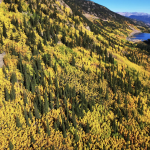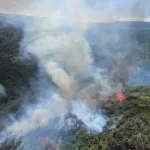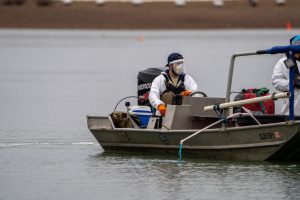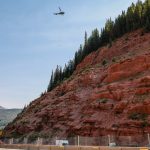Altitude sickness can hit some hard in Vail
VAIL, Colorado – For some visitors to the Vail Valley the first sign that they are “not in Kansas any more, Toto” is a look at the majestic grandeur of the Colorado Rockies.
For an unfortunate few, it can be the onset of a devastating headache. So what is this insidious demon that can afflict even some of our most hardy travelers?
Dr. Charles Tuft, who was an altitude expert with Alpine Mobile Physicians and a member of the Vail Valley Medical Center staff, said altitude illness can affect up to 25 percent of travelers to Vail but that its manifestations are not always dramatic.
Many know it only as a minor headache that comes each time they ascend and goes away within a few hours with or without Tylenol or aspirin. For others, though, a significant headache that can last for days can be accompanied by loss of appetite, nausea and even vomiting. A disturbing inability to sleep can be an additional problem, says Tuft, a doctor who makes house calls in the Vail Valley.
Fortunately, more severe forms of altitude illness are rare at this altitude but still do occur once in a while. One such illness is high-altitude pulmonary edema. Signs of high-altitude pulmonary edema are shortness of breath not caused by exertion, a cough, and possibly gurgling when breathing. This is severe — even life-threatening — and requires immediate medical attention.

Support Local Journalism
Rarely, if ever seen at Vail’s altitude, is high-altitude cerebral edema. Confusion and loss of balance are the hallmarks of this form of altitude illness. Like high-altitude pulmonary edema, this should be considered extremely severe and requires medical treatment.
So, who are affected and what can be done? Tuft says many travelers think physical training will prevent the problem. But Tuft has a story that he likes to tell to some of Alpine Mobile Physicians’ younger patients who feel cheated when they have become ill.
Tuft says the sickest patient he ever saw with altitude illness was the best athlete he has ever known. This patient was a world-class ultramarathoner who was a climber on the Everest expedition during which Tuft was the doctor. Clearly, if getting in shape were preventative, this person should have been exempt.
The reality is that altitude illness is an equal-opportunity disease. Anyone from the very young to the old, and from the couch potato to the most athletic, can be affected.
Prevention is sometimes as simple as an overnight stay at an intermediate altitude such as Denver. There is no good data to establish that drinking a lot of water will prevent the disease, but altitude illness can cause nausea, which can prevent you from re-hydrating, and you don’t want to start out behind. Dehydration is common in our climate and may by itself cause a headache.
Several drugs have been used for prevention. Some studies have shown that taking ginkgo biloba for five days before ascending to altitude can have benefits. Tuft says it may help, but studies are not conclusive.
Well established as a preventative, acetazolamide (Diamox) is often used and is about 75 percent effective. Started one day in advance, and continued through the next two days, it has the beneficial effects of a respiratory stimulant that can prevent a decrease in respirations during sleep, which is believed to be a cause of altitude illness.
Diamox is a diuretic, which can help combat water retention, particularly by the brain, which is another suspected cause of altitude illness. As a downside, in a dry climate, where dehydration is also a potential evil, that same water loss that diuretics create may become a problem. In addition, many people will have numb lips and fingers from Diamox. Tuft has had one patient who experienced the Diamox-induced hyperventilation as an acute anxiety attack.
Without side effects and very effective, prophylactic oxygen may be the best preventative. Many of Alpine Mobile Physicians’ patients start supplemental oxygen the first moment they arrive in their rooms in Vail, and breathe it for the first night continuously. These previous altitude illness sufferers nearly always go on to have a wonderful time at altitude without symptoms.
Preventative drugs and overnight oxygen may perhaps be overkill for most travelers, because most will not be affected and many will have only mild symptoms. Travelers to altitude should have an awareness of altitude illness and seek treatment if symptoms are significant, but prevention is not usually recommended.
Prevention is key, however, for those who have had altitude illness in the past. For unknown reasons, those who have been previously afflicted nearly always have it again.
Treatment of altitude illness usually involves oxygen. Within the first few minutes of oxygen therapy most patients feel dramatically better. But, they must remain on oxygen overnight to solidify the cure.
Short bursts of oxygen from a canister may also make you feel better, but unless you just happened to be just at the point that you were about to be over the illness, the improvement will likely not last, Tuft says.
Also interesting and available to Alpine Mobile Physicians patients are hyperbaric oxygen chambers. As Everest expedition physician, Tuft had the first functional version of this type of unit used to treat an ill patient at extreme altitude. Currently, these are suggested to be as effective as overnight oxygen, in a one-hour treatment.
If you need an immediate cure that is somewhat expensive and perhaps a bit disconcerting to crawl inside of, it can save you a night of sleeping with a quiet oxygen machine by your side. Alpine Mobile Physicians can be reached at 970-376-8376.










